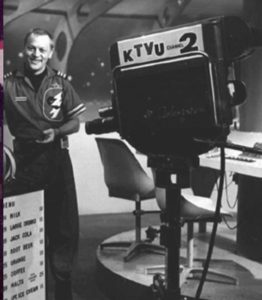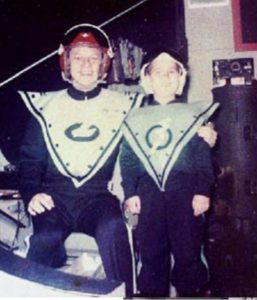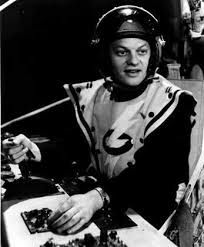By Kevin Wing
Senior Correspondent, Off Camera
Chapter Governor, San Francisco
Nine years ago, I had a wonderful opportunity to interview the man who played Captain Satellite on Bay Area television from the late 1950s to the late 1960s. Bob March, and his Captain Satellite alter ego, were easily identifiable to a generation of kids growing up in northern California during that time, all of whom watched March’s afternoon kiddie show on Oakland’s KTVU Channel 2 every afternoon after school.
That article about March appeared in Off Camera in 2010. A 1990 Silver Circle inductee, March is so honored for his more than 25 years of contributions to the Bay Area and northern California television industry.
It’s been nearly 10 years since I wrote March’s story as part of my Gold & Silver Circle Profiles series for this newsletter. It has also been 50 years since Captain Satellite left the air. I thought it would be nice to check in on March. After speaking with him on the phone, we decided to do another story for Off Camera. Recently, I traveled to the Sacramento area to meet with March. Believe it or not, he still has the Captain Satellite uniform, tucked away in his closet. 
First, let’s do a refresher on March and his career at KTVU, where he was, and always will be, known as Captain Satellite.
Before Captain Kirk, Luke Skywalker, Buck Rogers — even the Robinson family and their Robot from Lost in Space – there was Captain Satellite, who, courtesy of KTVU, flew in from outer space each weekday afternoon and into the living rooms of Bay Area children for more than a decade.
To the tens of thousands of children who watched Captain Satellite each weekday afternoon after school on KTVU, the popular afternoon kiddie show was the welcoming answer for kids of all ages after a long day of sitting in a classroom.
For most who have lived and worked in the Bay Area for a long time, Captain Satellite was the alter ego of March, a Bay Area television personality who arrived at KTVU as the station went on the air for the first time in March of 1958.
By the time March arrived at KTVU, he had already become a broadcasting veteran.
Born Robert Monkman in Racine, Wisconsin, he was immediately was drafted into the Army right out of high school. He knew that when he got out, he wanted to pursue his dream of being on the radio. He decided to adopt March as his stage name.
By 1947, at age 20, March got his big break. He was hired by WRJN radio in Racine. Working as a radio announcer there for several years, March eventually started setting his sights on the new medium of television. 
“I got to thinking at the time that this thing called TV could catch on,” March, now 92, said.
In 1954, Milwaukee’s CBS station, WXIX, hired him to produce and star in a children’s television show. March remained at the station for 18 months. During that time, the station, which was on the UHF dial at Channel 19 and had a terrible signal, began giving away free antennas so television viewers could watch the station with clarity from their living rooms.
A year and a half after he began at WXIX, March says most of the people at WXIX were from the Los Angeles area, and many of them planned to head back to California to find work. A friend suggested to March that he also head west to find out what his next chapter in television would be. So, he left Wisconsin and headed for the Golden State. March didn’t wind up in Los Angeles, but he was close – Bakersfield
“Where the hell is Bakersfield?” he remembered asking. “When I auditioned for them, I really had hoped I wouldn’t get the job. I didn’t want to work in Bakersfield.”
But, as fate would have it, that new station in Bakersfield hired March. He worked as an on-camera performer and also directed various programs. The year was 1956. March would remain there until 1957.
It was around that time that March heard there was a new independent station getting ready to launch itself in the Bay Area to compete against the three network stations in San Francisco.
“I heard that it was calling itself KTVU Channel 2, and it was in Oakland,” March said. “So, I got in touch with the station and they told me to come up for a visit. I came up to Oakland and met with Bill Pabst, the station’s original owner. Pabst told March what he could do for the station: create a children’s show based around a character named Captain Satellite, an idea spurred by March’s interest in space exploration and inspired by, in part, his childhood hero, Charles Lindbergh.
“I had it all well-organized,” March explained. “I had the whole show drawn out. I knew what I wanted the costumes to look like, the whole thing.”
Pabst was sold on the idea, and March became one of KTVU’s first employees, starting there a week after the station went on the air.
And so, in the spring of 1958, Captain Satellite debuted on KTVU, airing live for one hour every weekday afternoon beginning at 3:30 p.m.
The show soon became a smash hit with Bay Area children, fresh home from a day at school. March’s signature outfit on the air was a helmet and a dark uniform under a light-colored triangular vest, with artwork featuring a thunderbolt passing through a globe. The show’s set was a cutaway rocket ship called the Starfinder II (“two,” for Channel 2) which blasted off each afternoon.
“For the show’s entire run, we were on live, every day, from 3:30 to 4:30 in the afternoon, five days a week. There was no tape then. We did it live, all live,” March said.
To make the Captain Satellite show even more interesting, March established a working relationship with NASA Ames Research Center in Mountain View. From that union, NASA space footage would be sent periodically to March to feature on his show. The show also featured local children who would serve as March’s co-hosts every day. With them aboard the spaceship, the Starfinder II would orbit on auto-pilot, and the children would participate in games to win prizes.
“The kids who joined me as co-hosts would unlock what I used to call a ‘Space Lock,’ that when unlocked, would reveal a prize for them to take home,” March says. “We also included the kids who were watching at home, so they could win prizes, too.
To put it the way March does, Captain Satellite was a combination of entertainment and education. It was a winning combination, and the program was an afterschool hit in the ratings for many years.
“We had very good ratings,” March says. “The advertisers loved us. We had them all. Bosco Chocolate. You name it.”
The show also introduced cartoons. Occasionally, there would be special appearances, such as when The Three Stooges came to visit the Starfinder II. Also, the original seven Mercury astronauts made appearances on the program.
After the show ended just before the beginning of the 1970s, March continued on at the station for another five years, working as an announcer, and directing Nancy Besst as Miss Nancy on Romper Room. He also hosted the station’s Dialing for Dollars for a short time in the early 1970s. Finally, it was time for March to say goodbye to KTVU, and embark on a new chapter in his career. The station was phasing out the kiddie programs. “They offered me a buyout so I took it,” March says. “It was a nice chunk of change, so I decided to go back to school.
He taught broadcasting at San Francisco State; then in 1973, March earned his master’s degree in counseling, going to work in marriage and family counseling for several years.
But, March admits that the greatest joy of being Captain Satellite was working with the children on the show.
“I enjoyed working with the kids, helping them to learn and understand what the nation’s space program was all about,” he says.
March’s admiration for Lindbergh guided him to learning how to fly an airplane, eventually becoming a licensed pilot.
Married to his wife of 52 years, Alice – they celebrated their 52nd wedding anniversary in late August. They met in the 1960s when they were both cast in a play in the Bay Area.
“The name of the play was called ‘No Exit’, and I was cast opposite Alice,” March said.
The couple once lived in Berkeley and Pleasant Hill for many years, then in the 1990s, they moved to the Folsom area, and later, Placerville. For the last couple of years, they have been living in the Roseville area.
The walls of their bedroom are covered with mementos of March’s television career, including a framed photograph of him posing with The Three Stooges in the 1960s and a colored caricature of March in the 1970s. He also has a scrapbook that details his life: old photographs of his family, KTVU memorabilia, and a photograph of him with Clint Eastwood. March had a small role in Eastwood’s 1973 action thriller movie, Magnum Force.
Looking back at his colorful career, March said he had the time of his life.
“It was a lot of fun,” he said. “I spent half my life in front of a television camera. It was all so much fun.”
During this latest interview with March, this reporter showed him YouTube clips of Captain Satellite from the 1960s. He loved every moment of watching himself again after all these years.
Though it’s been 50 years since Captain Satellite left the Channel 2 airwaves, March still remembers those glorious years. And, he still thinks of all of his “space pals” who watched him on TV through the years.











